The Variability of Nitrogen Forms in Soils Due to Traditional and Precision Agriculture: Case Studies in Poland
Abstract
:1. Introduction
2. Materials and Methods
2.1. Study Site Description and Soil Sampling
- A experimental site: 1.1 mg kg−1 (NH4-N), 4.3 mg kg−1 (NO3-N), 0.4 g kg−1 (NKjeldahl);
- B experimental site: 0.9 mg kg−1 (NH4-N), 10.2 mg kg−1 (NO3-N), 0.8 g kg−1 (NKjeldahl);
- C experimental site: 1.9 mg kg−1 (NH4-N), 15.1 mg kg−1 (NO3-N), 0.6 g kg−1 (NKjeldahl).
2.2. Laboratory Analysis
2.3. Statistical Calculations
3. Results
3.1. Distribution of Soil Types
3.2. Statistical Testing of Differences between N Forms Content in Soil
3.3. Content of N Forms in Soil vs. Soil Depth
3.4. Content of N Forms in Soil vs. Soil Fractions
3.5. Spatial Fluctuations of N Content in Soil
4. Discussion
4.1. Typical Concentrations of N in Soil
4.2. Effect of Soil Type on N Forms Migration
4.3. Accumulation of N in Soil
4.4. Decrease of N Form Concentration through the Depth
4.5. Spatial Variability of N Forms Concentrations
4.6. Premises of Sustainable Development Goals (SDGs) Implementation
4.7. Future Research Needs
5. Conclusions
Author Contributions
Funding
Institutional Review Board Statement
Informed Consent Statement
Data Availability Statement
Acknowledgments
Conflicts of Interest
References
- Xia, X.; Zhang, S.; Li, S.; Zhang, J.; Wang, G.; Zhang, L.; Wang, J.; Li, Z. The cycle of nitrogen in river systems: Sources, transformation, and flux. Environ. Sci. Process. Impacts 2018, 20, 863–891. [Google Scholar] [CrossRef] [PubMed]
- Pajewski, T. Water pollution as a negative effect of agricultural activity. Sci. Ann. Assoc. Agric. Agribus. Econ. 2016, 18, 191–195. (In Polish) [Google Scholar]
- Bechmann, M. Nitrogen losses from agriculture in the Baltic Sea region. Long-term monitoring of nitrogen in surface and subsurface runoff from small agricultural dominated catchments in Norway. Agric. Ecosyst. Environ. 2014. [Google Scholar] [CrossRef]
- Vaverková, M.; Adamcová, D. Can Vegetation Indicate a Municipal Solid Waste Landfill’s Impact on the Environment? Polish J. Environ. Stud. 2014, 23, 501–509. [Google Scholar]
- Wick, K.; Heumesser, C.; Schmid, E. Groundwater nitrate contamination: Factors and indicators. J. Environ. Manag. 2012, 111, 178–186. [Google Scholar] [CrossRef] [PubMed] [Green Version]
- Kyllmar, K.; Bechmann, M.; Deelstra, J.; Iital, A.; Blicher-Mathiesen, G.; Jansons, V.; Koskiaho, J.; Povilaitis, A. Long-term monitoring of nutrient losses from agricultural catchments in the Nordic-Baltic region: A discussion of methods, uncertainties and future needs. Agric. Ecosyst. Environ. 2014, 198, 4–12. [Google Scholar] [CrossRef]
- Elbl, J.; Vaverková, M.; Adamcová, D.; Plošek, L.; Kintl, A.; Lošák, T.; Hynšt, J.; Kotovicová, J. Influence of fertilization on microbial activities, soil hydrophobicity and mineral nitrogen leaching. Ecol. Chem. Eng. S 2014, 21, 661–675. [Google Scholar] [CrossRef] [Green Version]
- Gao, S.; Xu, P.; Zhou, F.; Yang, H.; Zheng, C.; Cao, W.; Tao, S.; Piao, S.; Zhao, Y.; Ji, X.; et al. Quantifying nitrogen leaching response to fertilizer additions in China’s cropland. Environ. Pollut. 2016, 211, 241–251. [Google Scholar] [CrossRef] [PubMed]
- Mosier, A.R.; Syers, J.K.; Freney, J.R. Agriculture and the Nitrogen Cycle. In Assessing the Impacts of Fertilizer Use on Food Production and the Environment; Island Press: Washington, DC, USA, 2004. [Google Scholar]
- Gray, N.F. Drinking Water Quality. In Problems and Solutions, 2nd ed.; Cambridge University Press: Cambridge, UK, 2008. [Google Scholar]
- Füleky, G. Accumulation and depletion of fertilizer originated nitrate-N and ammonium-N in deeper soil layers. Columella J. Agric. Environ. Sci. 2014, 1, 7–16. [Google Scholar] [CrossRef]
- Jego, G.; Sanchez-Perez, J.M.; Justes, E. Predicting soil water and mineral nitro-gen contents with the STICS model for estimation nitrate leaching under agricultural fields. Agric. Water Manag. 2012, 107, 54–65. [Google Scholar] [CrossRef] [Green Version]
- Sieczka, A.; Bujakowski, F.; Falkowski, T.; Koda, E. Morphogenesis of a Floodplain as a Criterion for Assessing the Susceptibility to Water Pollution in an Agriculturally Rich Valley of a Lowland River. Water 2018, 10, 399. [Google Scholar] [CrossRef] [Green Version]
- Kalenik, M.; Chalecki, M. Investigations on the effectiveness of wastewater purification in medium sand with assisting clinoptilolite layer. Environ. Prot. Eng. 2019, 45, 117–126. [Google Scholar] [CrossRef]
- Eurostat. Available online: https://ec.europa.eu/eurostat/home (accessed on 12 September 2018).
- Mikula, K.; Izydorczyk, G.; Skrzypczak, D.; Mironiuk, M.; Moustakas, K.; Witek-Krowiak, A.; Chojnacka, K. Controlled release micronutrient fertilizers for precision agriculture—A Review. Sci. Total Environ. 2020, 712, 136365. [Google Scholar] [CrossRef] [PubMed]
- Kiełbasa, P.; Zagórda, M.; Jabłoński, P.; Koronczok, J. Porównanie zróżnicowania przewodności elektrycznej gleby wykonanej urządzeniem Topsoil Mapper i jej charakterystyk penetrometrycznych. Przegląd Elektrotechniczny 2020, 96, 146–150. (In Polish) [Google Scholar]
- Leszkowska, L.; Rzymowski, M.; Nyka, K.; Kulas, Ł. Simple Superstrate Antenna for Connectivity Improvement in Precision Farming Applications. In Proceedings of the 2020 IEEE International Symposium on Antennas and Propagation and North American Radio Science Meeting, Montréal, QC, Canada, 5–10 July 2020. [Google Scholar] [CrossRef]
- Niedbała, G. Application of Artificial Neural Networks for Multi-Criteria Yield Prediction of Winter Rapeseed. Sustainability 2019, 11, 533. [Google Scholar] [CrossRef] [Green Version]
- Barwicki, J.; Mazur, K.; Borek, K.; Wardal, W.J. Development of plant cultivation using precision agriculture. Polish Tech. Rev. 2019, 2, 15–20. [Google Scholar] [CrossRef]
- Barwicki, J.; Borek, K. Remote sensing in farm machinery design—As fundamental improvement of development—Of precision agriculture phenomenon. Polish Tech. Rev. 2019, 3, 26–30. [Google Scholar]
- Zawada, M.; Ciechanowski, M.; Szulc, T.; Szychta, M.; Smela, A.; Kamprowski, R. Systemy wizyjne we współczesnym rolnictwie. Technika Ogrodnicza Rolnicza i Leśna 2019, 1, 13–16. [Google Scholar]
- Lorencowicz, E. Cyfrowe rolnictwo-cyfrowe zarządzanie. Roczniki Naukowe Stowarzyszenia Ekonomistów Rolnictwa i Agrobiznesu 2018, XX, 104–110. (In Polish) [Google Scholar] [CrossRef]
- Piekutowska, M.; Niedbała, G.; Adamski, M.; Czechlowski, M.; Wojciechowski, T.; Czechowska-Kosacka, A.; Wójcik Oliveira, K. Modeling methods of predicting potato yield—Examples and possibilities of application. J. Res. Appl. Agric. Eng. 2018, 63, 176–180. [Google Scholar]
- Czechlowski, M.; Wojciechowski, T.; Adamski, M.; Niedbała, G.; Piekutowska, M. Application of ASG-EUPOS high precision positioning system for cereal harvester monitoring. J. Res. Appl. Agric. Eng. 2018, 63, 44–50. [Google Scholar]
- Usowicz, B.; Lipiec, J. Spatial variability of soil properties and cereal yield in a cultivated field on sandy soil. Soil Tillage Res. 2017, 174, 241–250. [Google Scholar] [CrossRef]
- Mazur, P.; Chojnacki, J. Wykorzystanie dronów do teledetekcji. Technika Rolnicza Ogrodnicza Leśna 2017, 1, 25–28. [Google Scholar]
- Laskowska, P.J. Informatyka w rolnictwie, czyli rolnictwo precyzyjne. In Materiały pokonferencyjne III Ogólnopolskiej Konferencji Interdyscyplinarnej “Współczesne Zastosowania Informatyki”; Instytut Informatyki Uniwersytetu Przyrodniczo-Humanistycznego w Siedlcach: Siedlce, Poland, 2017. (In Polish) [Google Scholar]
- Samborski, S.M.; Gozdowski, D.; Walsh, O.S.; Kyveryga, P.; Stępień, M. Sensitivity of sensor-based nitrogen rates to selection of within-field calibration strips in winter wheat. Crop Pasture Sci. 2017, 68, 101–114. [Google Scholar] [CrossRef]
- Żak, A. Innovations in plant production as an opportunity for Polish agriculture. J. Agribus. Rural Dev. 2017, 1, 239–246. [Google Scholar] [CrossRef]
- Borusiewicz, A.; Kapela, K.; Drożyner, P.; Marczuk, T. Application of precision agriculture technology in Podlaskie Voivodeship. Agric. Eng. 2016, 20, 5–11. [Google Scholar] [CrossRef] [Green Version]
- Berner, B.; Chojnacki, J. Wykorzystanie dronów w rolnictwie precyzyjnym. Technika Rolnicza Ogrodnicza Leśna 2016, 6, 19–21. [Google Scholar]
- Samborski, S.M.; Gozdowski, D.; Stępień, M.; Walsh, O.S.; Leszczyńska, E. On-farm evaluation of an active optical sensor performance for variable nitrogen application in winter wheat. Eur. J. Agronomy 2016, 74, 56–67. [Google Scholar] [CrossRef]
- Wójtowicz, M.; Wójtowicz, A.; Piekarczyk, J. Application of remote sensing methods in agriculture. Commun. Biometry Crop Sci. 2016, 11, 31–50. [Google Scholar]
- Wójcicki, Z.; Rudeńska, B. Systemy rolniczej produkcji ekologicznej i precyzyjnej (informacyjnej). Problemy Inżynierii Rolniczej 2015, 2, 5–15. [Google Scholar]
- Gozdowski, D.; Stępień, M.; Samborski, S.; Dobers, E.S.; Szatyłowicz, J.; Chormański, J. Prediction accuracy of selected spatial interpolation methods for soil texture at farm field scale. J. Soil Sci. Plant Nutr. 2015, 15, 639–650. [Google Scholar] [CrossRef] [Green Version]
- Borsato, E.; Galindo, A.; Tarolli, P.; Sartori, L.; Marinello, F. Evaluation of the Grey Water Footprint Comparing the Indirect Effects of Different Agricultural Practices. Sustainability 2018, 10, 3992. [Google Scholar] [CrossRef] [Green Version]
- Kabala, C.; Karczewska, A.; Gałka, B.; Cuske, M.; Sowiński, J. Seasonal dynamics of nitrate and ammonium ion concentrations in soil solutions collected using MacroRhizon suction cups. Environ. Monit. Assess. 2017, 189, 304. [Google Scholar] [CrossRef] [PubMed] [Green Version]
- Staszewski, Z. Nitrogen in soil and its impact on the environment. Sci. Notebooks Civ. Eng. Environ. Improv. 2011, 4, 50–58. (In Polish) [Google Scholar]
- Pawlak, J. Precision farming, its role and economic efficiency. Adv. Agric. Sci. 2008, 1, 3–14. (In Polish) [Google Scholar]
- Gao, T.; Pang, H.; Zhang, J.; Zhang, H.; Zhou, J. Migration and transformation rule of nitrogen in vadose zone and groundwater: A case of Hebei plain. In Proceedings of the 2011 International Conference on Electrical and Control Engineering, Yichang, China, 16–18 September 2011; pp. 3524–3527. [Google Scholar] [CrossRef]
- Sieczka, A.; Bujakowski, F.; Koda, E. Modelling groundwater flow and nitrate transport: A case study of an area used for precision agriculture in the middle part of the Vistula River valley, Poland. Geologos 2018, 24, 225–235. [Google Scholar] [CrossRef] [Green Version]
- Koda, E.; Sieczka, A.; Osiński, P. Ammonium Concentration and Migration in Groundwater in the Vicinity of Waste Management Site Located in the Neighborhood of Protected Areas of Warsaw, Poland. Sustainability 2016, 8, 1253. [Google Scholar] [CrossRef] [Green Version]
- Kottek, M.; Grieser, J.; Beck, C.; Rudolf, B.; Rubel, F. World Map of the Köppen-Geiger climate classification updated. Meteorol. Z. 2006, 15, 259–263. [Google Scholar] [CrossRef]
- PN-B-04481:1988. Soils. In Soil Sample Testing; Polish Committee for Standardization: Warsaw, Poland, 1988. (In Polish) [Google Scholar]
- U.S. Department of Agriculture. Soil Conservation Service. In Soil Survey Staff. Soil Survey Manual; Agricultural Handbook No. 18; U.S. Department of Agriculture: Washington, DC, USA, 1951. [Google Scholar]
- FOSS Tecator AB. Application Sub Note 3313, The Determination of Nitrogen According to Kjedahl in Soil; FOSS: Höganäs, Sweden, 2003. [Google Scholar]
- Mann, H.B.; Whitney, D.R. On a test of whether one of two random variables is stochastically larger than the other. Ann. Math. Stat. 1947, 18, 50–60. [Google Scholar] [CrossRef]
- Rabiej, M. Statistical Analysis with Statistica and Excel; Helion: Gliwice, Poland, 2018. (In Polish) [Google Scholar]
- Kruskal, W.H.; Wallis, W.A. Use of ranks in one-criterion variance analysis. J. Am. Stat. Assoc. 1952, 47, 583–621. [Google Scholar] [CrossRef]
- Oliver, M.A.; Webster, R. How geostatistics can help you? Soil Use Manag. 1991, 7, 206–217. [Google Scholar] [CrossRef]
- Monitoring of Soil Chemistry in Poland. Available online: http://www.gios.gov.pl/chemizm_gleb/ (accessed on 20 August 2020).
- District Chemical-Agricultural Station in Lublin (DCAS). Nitrogen in Soil. Available online: http://www.oschr.pl/index.php/aktualnoci/45-azot-w-glebie.html (accessed on 12 June 2020).
- Lee, J.; Garland, G.M.; Viscarra Rossel, R.A. Continental soil drivers of ammonium and nitrate in Australia. Soil 2018, 4, 213–224. [Google Scholar] [CrossRef] [Green Version]
- Environmental Protection Inspection (EPI). Monitoring of Soil Chemistry in Poland in 2010–2012; Environmental Monitoring Library: Warsaw, Poland, 2012. (In Polish) [Google Scholar]
- Arbačauskas, J.; Masevičienė, A.; Žičkienė, L.; Staugaitis, G. Mineral nitrogen in soils of Lithuania’s agricultural land: Comparison of oven-dried and field-moist samples. Zemdirb. Agric. 2018, 105, 99–104. [Google Scholar] [CrossRef] [Green Version]
- Długosz, J.; Piotrowska-Długosz, A. Spatial variability of soil nitrogen forms and the activity of N-cycle enzymes. Plant Soil Environ. 2016, 62, 502–507. [Google Scholar] [CrossRef]
- Yan, C.; Du, T.; Yan, S.; Dong, S.; Gong, Z.; Zhang, Z. Changes in the inorganic nitrogen content of the soil solution with rice straw retention in northeast China. Desalin. Water Treat. 2018, 110, 337–348. [Google Scholar] [CrossRef] [Green Version]
- Sądej, W.; Przekwas, K. Fluctuations of nitrogen levels in soil profile under conditions of a long-term fertilization experiment. Plant Soil Environ. 2008, 54, 197–203. [Google Scholar] [CrossRef] [Green Version]
- Bahmani, O.; Nasab, S.B.; Behzad, M.; Naseri, A.A. Assessment of nitrogen accumulation and movement in soil profile under different irrigation and fertilization regime. Asian J. Agric. Res. 2009, 3, 38–46. [Google Scholar] [CrossRef] [Green Version]
- Sieczka, A.; Koda, E. Kinetic and Equilibrium Studies of Sorption of Ammonium in the Soil-Water Environment in Agricultural Areas of Central Poland. Appl. Sci. 2016, 6, 269. [Google Scholar] [CrossRef] [Green Version]
- Witheetrirong, Y.; Tripathi, N.K.; Tipdecho, T.; Parkpian, P. Estimation of the effect of soil texture on nitrate-nitrogen content in groundwater using optical remote sensing. Int. J. Environ. Res. Public Health 2011, 8, 3416–3436. [Google Scholar] [CrossRef] [Green Version]
- Gami, S.K.; Lauren, J.G.; Duxbury, J.M. Influence of soil texture and cultivation on carbon and nitrogen levels in soils of the eastern Indo-Gangetic Plains. Geoderma 2009, 153, 304–311. [Google Scholar] [CrossRef]
- Ibrahim, H.; Hatira, A.; Gallali, T. Relationship between nitrogen and soil properties: Using multiple linear regressions and structural equation modeling. Int. J. Res. Appl. Sci. 2013, 2, 1–7. [Google Scholar]
- Corinna, M.; Markus, K.; Reinhold, J. Soil organic matter stabilization pathways in clay sub-fractions from a time series of fertilizer deprivation. Org. Geochem. 2005, 36, 1311–1322. [Google Scholar] [CrossRef]
- Alamgir, M. The effects of soil properties to the extent of soil contamination with metals. In Environmental Remediation Technologies for Metal-Contaminated Soils; Hasegawa, H., Rahman, I.M.M., Rahman, M.A., Eds.; Springer: Berlin/Heidelberg, Germany, 2016; pp. 1–19. [Google Scholar]
- Xu, G.; Li, Z.; Li, P. Fractal features of soil particle-size distribution and total soil nitrogen distribution in a typical watershed in the source area of the middle Dan River, China. Catena 2013, 101, 17–23. [Google Scholar] [CrossRef]
- Tkaczyk, P.; Bednarek, W.; Dresler, S.; Krzyszczak, J. The effect of some soil physicochemical properties and nitrogen fertilisation on winter wheat yield. Acta Agrophys. 2018, 25, 107–116. [Google Scholar] [CrossRef]
- Lopez-Bellido, L.; Munoz-Romero, V.; Lopez-Bellido, R.J. Nitrate accumulation in the soil profile: Long-term effects of tillage, rotation and N rate in a Mediterranean Vertisol. Soil Tillage Res. 2013, 130, 18–23. [Google Scholar] [CrossRef]
- Sieczka, A.; Koda, E. Identification of nitrogen compounds sorption parameters in the soil-water environment of a column experiment. Ochr. Sr. 2016, 38, 29–34. (In Polish) [Google Scholar]
- Uwah, E.I.; Abah, J.; Ndahi, N.P.; Ogugbuaja, V.O. Concentration levels of nitrate and nitrite in soils and some leafy vegetables obtained in Maiduguri, Nigeria. J. Appl. Sci. Environ. Sanit. 2009, 4, 233–244. [Google Scholar]
- Cain, M.L.; Subler, S.; Evans, J.P.; Fortin, M.J. Sampling spatial and temporal variation in soil nitrogen availability. Oecologia 1999, 118, 397–404. [Google Scholar] [CrossRef]
- Hope, D.; Zhu, W.; Gries, C.; Oleson, J.; Kaye, J.; Baker, L.A. Spatial variation in soil inorganic nitrogen across an arid urban ecosystem. Urban Ecosyst. 2005, 8, 251–273. [Google Scholar] [CrossRef]
- Spohn, M.; Novák, T.J.; Incze, J.; Giani, L. Dynamics of soil carbon, nitrogen, and phosphorus in calcareous soils after land-use abandonment—a chronosequence study. Plant Soil 2016, 401, 185–196. [Google Scholar] [CrossRef]
- Liu, Y.; Gao, P.; Zhang, L.; Niu, X.; Wang, B. Spatial heterogeneity distribution of soil total nitrogen and total phosphorus in the Yaoxiang watershed in a hilly area of northern China based on geographic information system and geostatistics. Ecol. Evol. 2016, 6, 6807–6816. [Google Scholar] [CrossRef] [PubMed]
- Tang, X.; Xia, M.; Guan, F.; Fan, S. Spatial Distribution of Soil Nitrogen, Phosphorus and Potassium Stocks in Moso Bamboo Forests in Subtropical China. Forests 2016, 7, 267. [Google Scholar] [CrossRef] [Green Version]
- Morales, L.A.; Vázquez, E.V.; Paz-Ferreiro, J. Spatial distribution and temporal variability of ammonium-nitrogen, phosphorus, and potassium in a rice field in Corrientes, Argentina. Sci. World J. 2014, 2014, 135906. [Google Scholar] [CrossRef] [PubMed] [Green Version]
- Koda, E.; Osiński, P.; Sieczka, A.; Wychowaniak, D. Areal Distribution of Ammonium Contamination of Soil-Water Environment in the Vicinity of Old Municipal Landfill Site with Vertical Barrier. Water 2015, 7, 2656–2672. [Google Scholar] [CrossRef]
- Gallardo, A.; Parama, R.; Covelo, F. Differences between soil ammonium and nitrate spatial pattern in six plant communities. Simulated effect on plant populations. Plant Soil 2006, 279, 333–346. [Google Scholar] [CrossRef]
- Podlasek, A.; Bujakowski, F.; Koda, E. The spread of nitrogen compounds in an active groundwater exchange zone within a valuable natural ecosystem. Ecol. Eng. 2020, 146, 105746. [Google Scholar] [CrossRef]
- Sieczka, A. Migracja Związków Azotu Pochodzenia Nawozowego w Środowisku Gruntowo-Wodnym [Migration of Nitrogen Compounds from Fertilizers in the Soil-Water Environment]. Ph.D. Thesis, Warsaw University of Life Sciences, Warsaw, Poland, 2018. (In Polish). [Google Scholar]



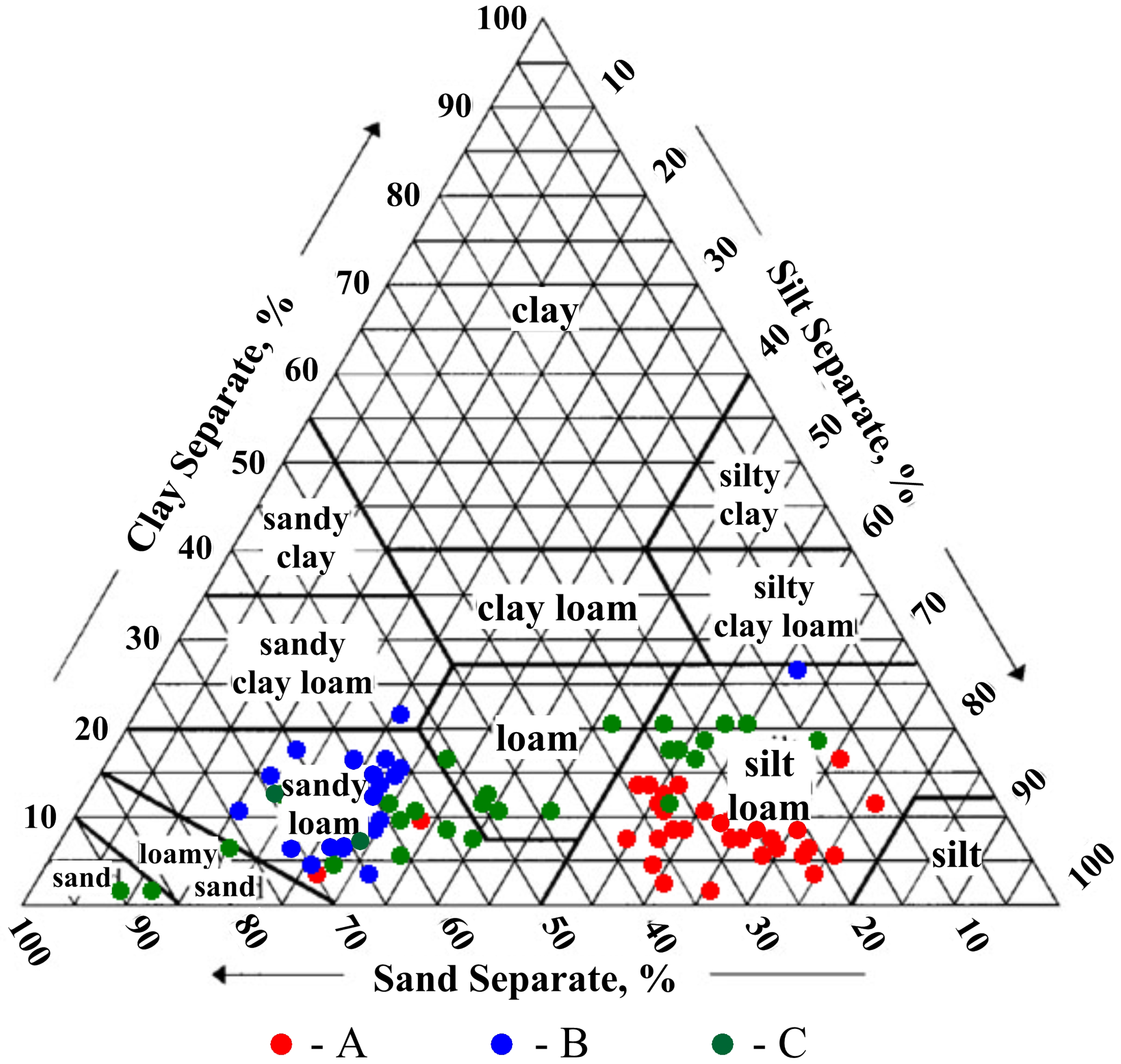

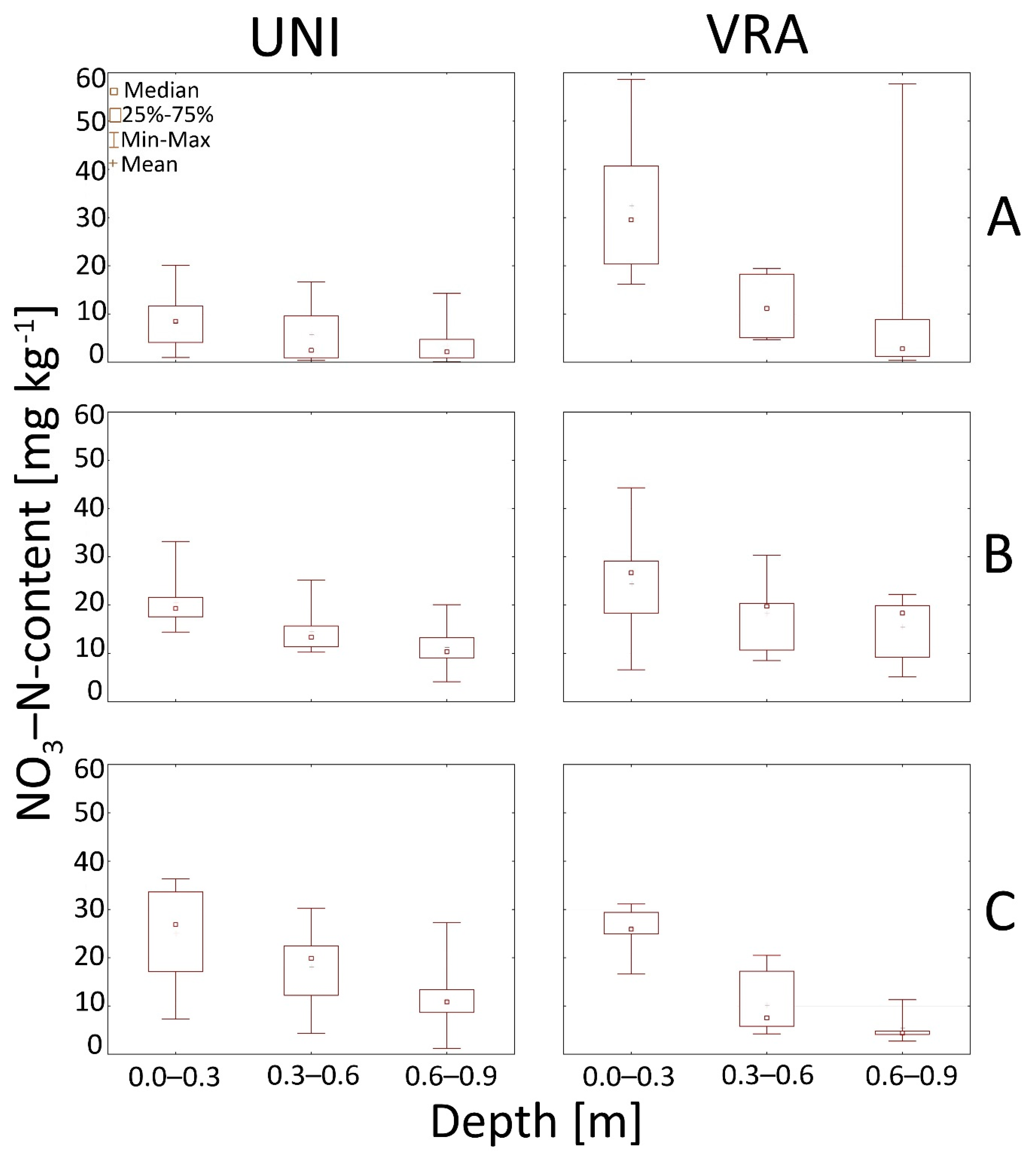

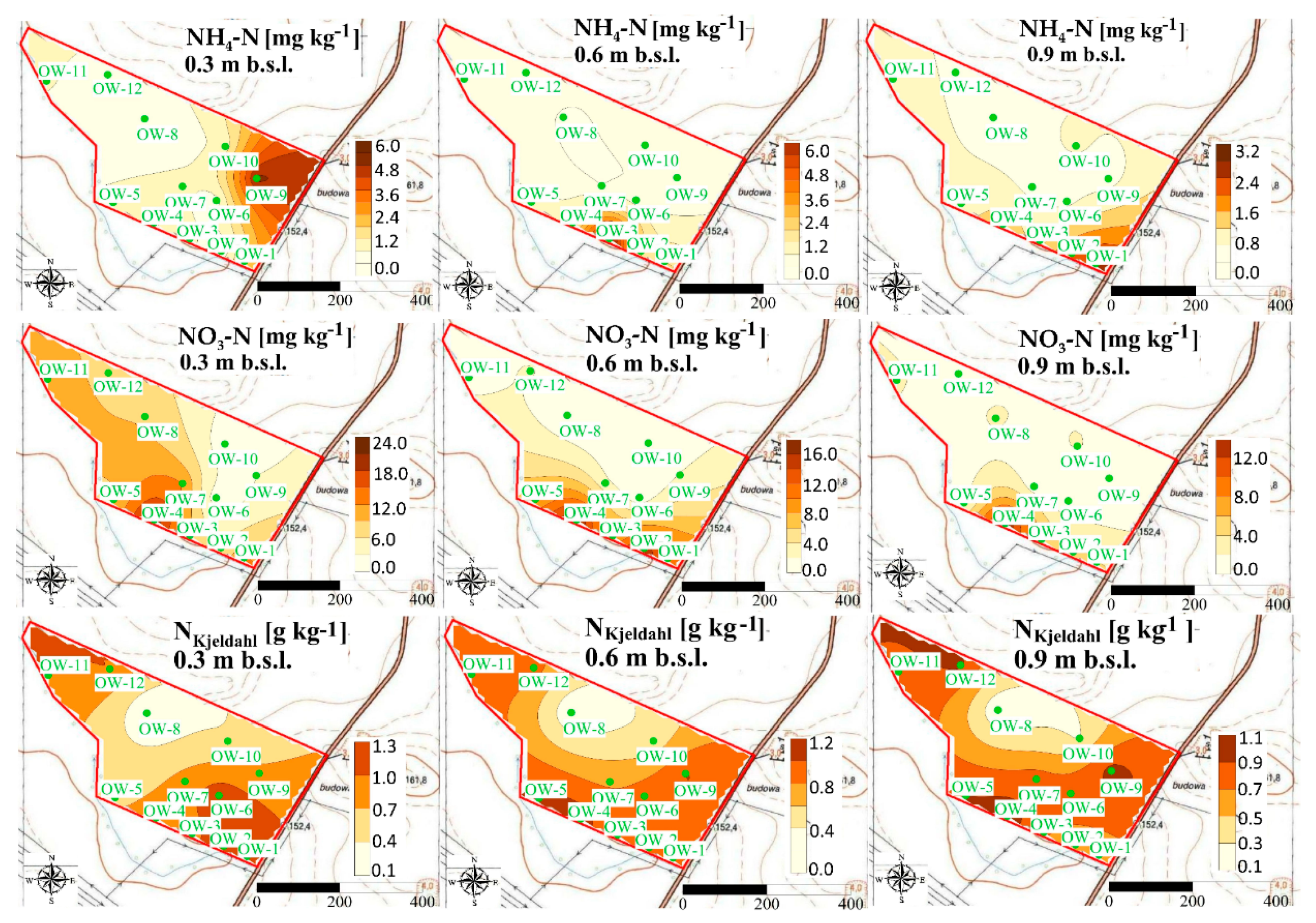


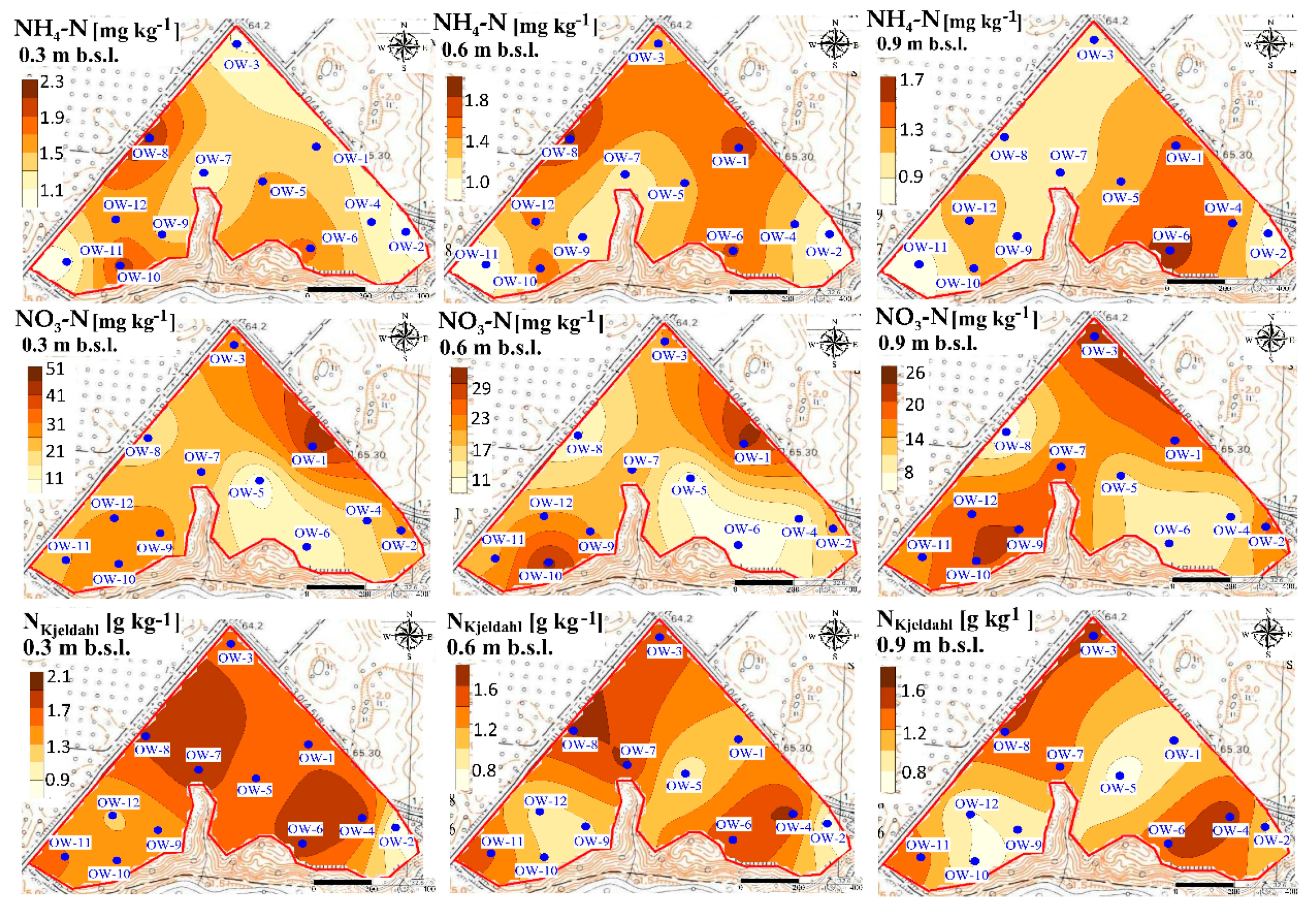
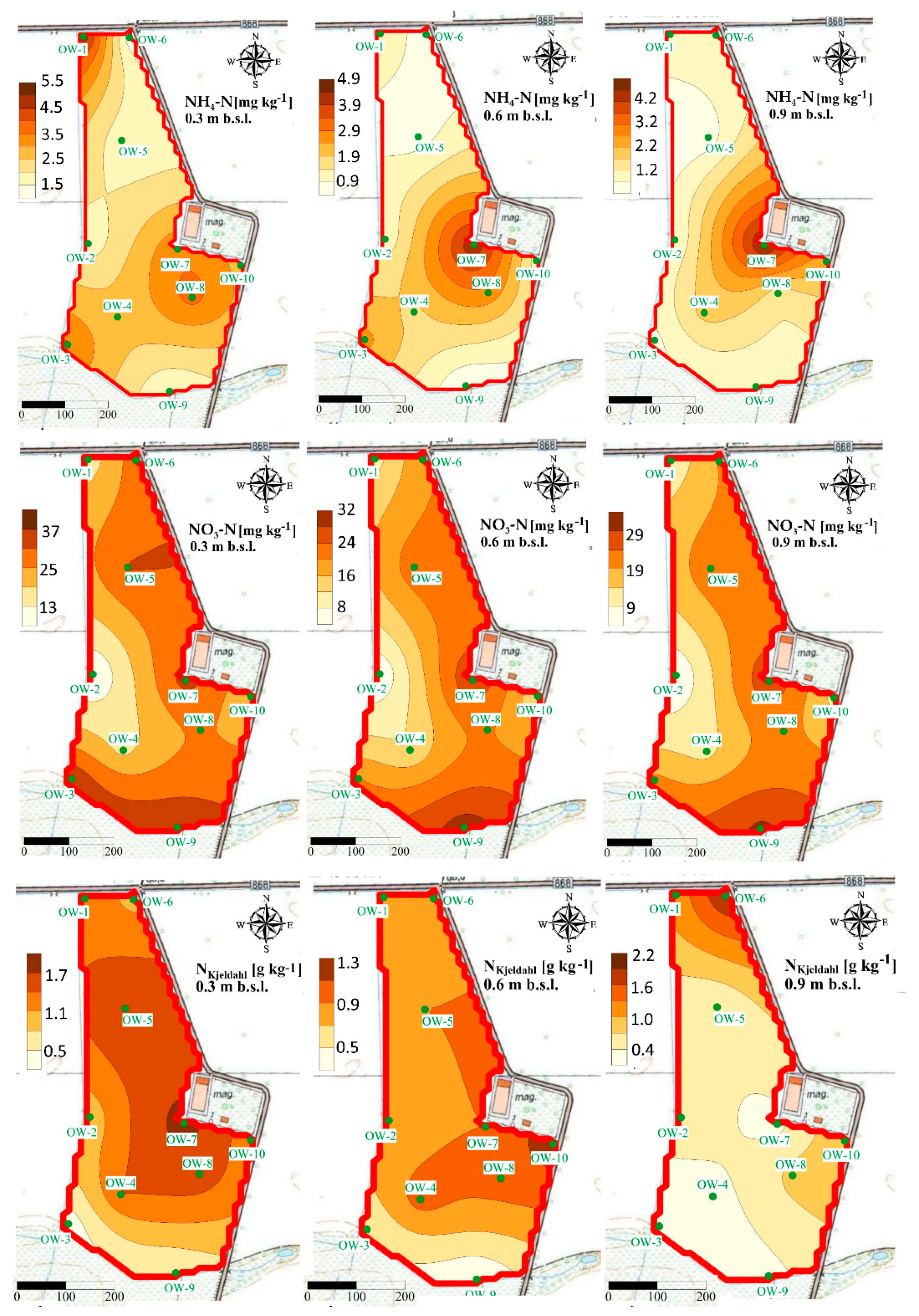

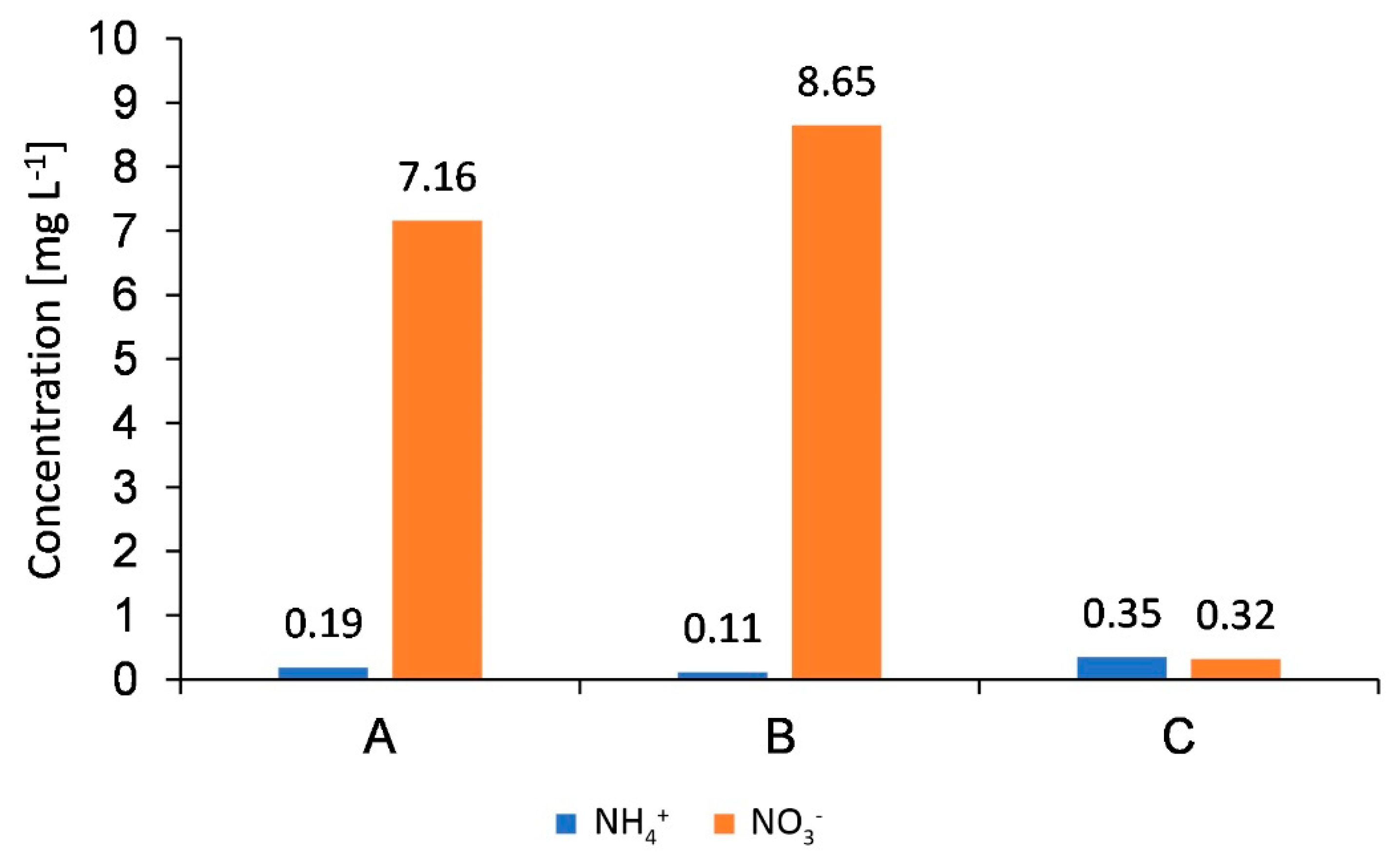
| No. | Objective | Key Results | Ref. |
|---|---|---|---|
| 1 | Presentation of the existing methods of micronutrient fertilization. | Precise fertilization techniques based on low-solubility fertilizers, coated fertilizers, bio-based, and nanofertilizers are a new trend in modern agriculture. | [16] |
| 2 | Identifying the diversity of soil profile cohesion on the basis of non-invasive measurement of the electrical conductivity. | Maps of spatial differentiation of electrical conductivity within the field for their further use in precision agriculture. | [17] |
| 3 | Concept of a circularly polarized antenna with partially reflecting surface (PRS) has been adopted for precision farming applications. | Designed antennas employed for point-to-point communication in systems of mobile devices or vehicles used under precision farming. | [18] |
| 4 | Creation of independent, multi-criteria models for the prediction of winter rapeseed yield. | Forecasting winter rapeseed yields using artificial neural networks makes it possible to obtain an accurate yield forecast before harvesting. The concept of neural modeling may contribute to sustainability by reducing the doses of mineral fertilizers. | [19] |
| 5 | Study on precision agriculture concept and application. | Obtaining data concerning spatial variability of soil and plants, discussion on remote sensing, and advanced digital technology application in precision agriculture. | [20] |
| 6 | Study on the use of remote sensing in precision agriculture. | Discussion on precision agriculture in aspect of steering of farm machinery, monitoring of biomass and crop yields, soil collection, doses of mineral fertilization. | [21] |
| 7 | Analysis of use of machine vision in modern agriculture. | Examples of the use of the CloverCam system, the WeedSeeker system, Robot RoniBob Amazone Bosch, autonomous robot Agrobob. | [22] |
| 8 | Presentation of the latest trends related to the digitization of agricultural processes. | Due to the process of digitization of agriculture, in the near future, resource management will be more effective, which will reduce the impact of farming and crops on the environment, supporting sustainable agriculture. | [23] |
| 9 | Estimation of potato yields. | Examples of use of remote sensing, vegetation indices, forecasting models, artificial neural networks, and image analysis methods in yields prediction. | [24] |
| 10 | Analysis of the application of a high precision positioning system ASG-EUPOS and its service NAWGEO for agricultural machines positioning. | Field tests show usefulness of the ASG-EUPOS network and its VRS NAWGEO service for precise positioning of agricultural machinery in dynamic conditions. The obtained data can be used to create numerical models of fields on-line, for example, in selective cereals harvesting technology. | [25] |
| 11 | Identification of soil properties in different weather conditions during the growing season and mapping soil properties and crop yields using inverse distance weighting. | Geostatistical analysis is a useful tool to determine spatial interrelationships of crop yield and soil properties in the scale of agricultural field. | [26] |
| 12 | Analysis of vegetation indices used to carry out a precise and non-invasive assessment of plants condition. | Creation of vegetation indices maps (NDVI, GNDVI, SAVI). It was concluded that proper interpretation of the obtained indicators will allow for the preparation of fertilizer applications. | [27] |
| 13 | Analysis of precision agriculture methods and application. | The application of the principles of precision farming has a positive effect on reducing contamination. Discussion on variable rate application of fertilizers. | [28] |
| 14 | Evaluation of the sensitivity of sensor-based N-rate prescriptions for winter wheat to selection of sample strips for AOS calibration. | The choice of a sample strip for AOS calibration could significantly affect sensor variable N rates prescribed for winter wheat. | [29] |
| 15 | Presentation of innovative solutions for plant production in Poland. | Innovative technologies in agricultural production may reduce the negative impact of climate change. | [30] |
| 16 | Evaluation of the precision agriculture technology on the territory of Podlaskie Voivodeship in Poland. | Only 10% of farmers use the positioning system and only 8% of the surveyed farmers apply the system for guiding agricultural machines. In addition, 14% of the investigated farmers use the system of parallel guiding. | [31] |
| 17 | Analysis of techniques for photographing and scanning crops from drones and creating field maps. | Information was obtained that could be read by the automatic control systems of machines used for fertilization and plant protection, as well as for harvesting crops. It was concluded that the use of drones in agriculture contributes to economic results. | [32] |
| 18 | Evaluation of the performance of active optical sensor (AOS) by determination of grain yield, N fertilizer use, grain protein content, N use efficiency, and N balance, utilizing a built-in algorithm for variable N rate fertilization of winter wheat. | Implementation of AOS for variable N application would minimize N surplus in areas of low productivity and improve the sustainability of N management. | [33] |
| 19 | Analysis of the use of remote sensing data in crop yield forecasting, assessing nutritional requirements of plants and nutrient content in soil, determining plant water demand and weed control. | Use of remote sensing to determine fertilization needs of plants based on the nutrient content of crops and soils helps to increase yields and improve the crop profitability. | [34] |
| 20 | Presentation of the evolutionary transition of conventional systems of agricultural activity to environmentally sustainable systems, integrated with the rural environment. | The concept of the organization of the agricultural precision production system in selected (certified) ecological farms was presented. | [35] |
| 21 | Evaluation of the soil texture prediction accuracy and the main criteria by which prediction accuracy is estimated. | All soil texture fractions were predicted with similar accuracy, using inverse distance weighting, radial basis function, ordinary kriging, and ordinary cokriging. | [36] |
| Characteristics | Experimental Site | ||
|---|---|---|---|
| A | B | C | |
| Area | 20 km2 | 40 km2 | 20 km2 |
| Climate classification 1 | Cfb | Dfb | Cfb |
| Average annual temperature | 9.5 °C | 8.2 °C | 9.0 °C |
| Total annual precipitation | 646 | 721 | 612 |
| First sampling/fertilization type | May/UNI | May/UNI | May/UNI |
| Days from UNI fertilization to soil sampling | 46 | 33 | 25 |
| Second sampling/fertilization | September/VRA | November/VRA | September/VR |
| Days from VRA fertilization to soil sampling | 136 | 159 | 126 |
| Fertilizer used—UNI | 32% ammonium nitrate | 32% urea ammonium nitrate solution | 24% N and 15% S Sulfan |
| Fertilizer used—VRA | 32% ammonium nitrate | 32% ammonium nitrate | 34% ammonium nitrate |
| UNI fertilization doses | 74 kg N ha−1 | 80 kg N ha−1 | 60 kg N ha−1 |
| VRA fertilization doses | 30–70 kg N ha−1 | 40–90 kg N ha−1 | 55–105 kg N ha−1 |
| N Form | Field | Test | p Value | Mean Concentration 1 ± SD 2 | |
|---|---|---|---|---|---|
| UNI | VRA | ||||
| NH4-N | A | Mann–Whitney U | 0.000867 3 | 1.49 ± 1.38 | 4.59 ± 4.46 |
| B | Mann–Whitney U | 0.018582 3 | 1.10 ± 0.22 | 1.29 ± 0.35 | |
| C | Mann–Whitney U | 0.083671 | 1.23 ± 0.44 | 1.96 ± 1.33 | |
| NO3-N | A | Mann–Whitney U | 0.002866 3 | 5.49 ± 5.40 | 18.78 ± 18.23 |
| B | Student t | 0.027702 3 | 15.46 ± 5.88 | 19.34 ± 8.53 | |
| C | Mann–Whitney U | 0.079757 | 13.81 ± 10.03 | 18.08 ± 10.02 | |
| NKjeldahl | A | Mann–Whitney U | 0.000000 3 | 0.79 ± 0.28 | 1.54 ± 0.36 |
| B | Mann–Whitney U | 0.068934 | 1.49 ± 0.54 | 1.30 ± 0.38 | |
| C | Student t | 0.000140 3 | 1.39 ± 0.49 | 0.88 ± 0.48 | |
| Depth | NH4-N | NO3-N | NKjeldahl | Fertilization | Experimental Site |
| −0.16 | −0.32 | −0.17 | UNI | A | |
| −0.59 1 | −0.47 | −0.71 1 | VRA | ||
| −0.24 | −0.65 1 | −0.52 1 | UNI | B | |
| −0.38 1 | −0.44 1 | −0.46 1 | VRA | ||
| −0.38 1 | −0.58 1 | −0.43 1 | UNI | C | |
| −0.69 1 | −0.85 1 | −0.55 1 | VRA |
| Fertilization | N Form | Equation | Maximum Depth D [m] |
|---|---|---|---|
| UNI | NH4-N | NH4-N = 2.0787 − 0.9813 × D | 2.11 |
| UNI | NO3-N | NO3-N = 21.511 − 14.67 × D | 1.46 |
| UNI | NKjeldahl | NKjeldahl = 1.4910 − 0.7103 × D | 2.09 |
| VRA | NH4-N | NH4-N = 4.4291 − 3.786 × D | 1.16 |
| VRA | NO3-N | NO3-N = 32.189 − 25.14 × D | 1.28 |
| VRA | NKjeldahl | NKjedahl = 1.8387 − 0.7958 × D | 2.31 |
| Depth | Parameter | NH4-N | N-NO3 | NKjeldahl |
|---|---|---|---|---|
| 0.00–0.30 m b.s.l. | NH4-N | 1.00 | 0.35 | −0.10 |
| NO3-N | 0.35 | 1.00 | 0.35 1 | |
| NKjeldahl | −0.10 | 0.35 1 | 1.00 | |
| Sa | −0.04 | 0.39 1 | 0.68 1 | |
| Si | 0.02 | −0.47 1 | −0.67 1 | |
| Cl | 0.45 1 | 0.26 | −0.12 | |
| Si + Cl | 0.05 | −0.39 1 | −0.69 1 | |
| 0.30–0.60 m b.s.l. | NH4-N | 1.00 | 0.31 | 0.21 |
| NO3-N | 0.31 | 1.00 | 0.16 | |
| NKjeldahl | 0.21 | 0.16 | 1.00 | |
| Sa | 0.00 | 0.36 1 | 0.57 1 | |
| Si | −0.11 | −0.44 1 | −0.57 1 | |
| Cl | 0.24 | 0.29 | −0.10 | |
| Si + Cl | −0.01 | −0.35 | −0.57 1 | |
| 0.60–0.90 m b.s.l. | NH4-N | 1.00 | 0.42 1 | 0.13 |
| NO3-N | 0.42 1 | 1.00 | 0.11 | |
| NKjeldahl | 0.13 | 0.11 | 1.00 | |
| Sa | 0.19 | 0.46 1 | 0.39 1 | |
| Si | −0.15 | −0.48 1 | −0.41 1 | |
| Cl | −0.04 | 0.15 | 0.00 | |
| Si + Cl | −0.15 | −0.38 1 | −0.38 1 |
| Depth | Parameter | N-NH4 | N-NO3 | NKjeldahl |
|---|---|---|---|---|
| 0.00–0.30 m b.s.l. | NH4-N | 1.00 | 0.09 | 0.30 |
| NO3-N | 0.09 | 1.00 | −0.21 | |
| NKjeldahl | 0.30 | −0.21 | 1.00 | |
| Sa | −0.56 1 | −0.09 | −0.35 | |
| Si | 0.58 1 | 0.15 | 0.32 | |
| Cl | −0.09 | −0.24 | 0.26 | |
| Si + Cl | 0.55 1 | 0.08 | 0.33 | |
| 0.30–0.60 m b.s.l. | NH4-N | 1.00 | −0.06 | 0.11 |
| NO3-N | −0.06 | 1.00 | −0.08 | |
| NKjeldahl | 0.11 | −0.08 | 1.00 | |
| Sa | −0.20 | 0.02 | −0.32 | |
| Si | 0.16 | −0.05 | 0.24 | |
| Cl | −0.05 | 0.12 | 0.26 | |
| Si + Cl | 0.21 | −0.01 | 0.30 | |
| 0.60–0.90 m b.s.l. | NH4-N | 1.00 | 0.41 1 | 0.18 |
| NO3-N | 0.41 1 | 1.00 | −0.05 | |
| NKjeldahl | 0.18 | −0.05 | 1.00 | |
| Sa | −0.19 | 0.16 | −0.31 | |
| Si | 0.23 | −0.04 | 0.31 | |
| Cl | 0.09 | 0.06 | 0.18 | |
| Si + Cl | 0.28 | −0.05 | 0.28 |
Publisher’s Note: MDPI stays neutral with regard to jurisdictional claims in published maps and institutional affiliations. |
© 2021 by the authors. Licensee MDPI, Basel, Switzerland. This article is an open access article distributed under the terms and conditions of the Creative Commons Attribution (CC BY) license (http://creativecommons.org/licenses/by/4.0/).
Share and Cite
Podlasek, A.; Koda, E.; Vaverková, M.D. The Variability of Nitrogen Forms in Soils Due to Traditional and Precision Agriculture: Case Studies in Poland. Int. J. Environ. Res. Public Health 2021, 18, 465. https://doi.org/10.3390/ijerph18020465
Podlasek A, Koda E, Vaverková MD. The Variability of Nitrogen Forms in Soils Due to Traditional and Precision Agriculture: Case Studies in Poland. International Journal of Environmental Research and Public Health. 2021; 18(2):465. https://doi.org/10.3390/ijerph18020465
Chicago/Turabian StylePodlasek, Anna, Eugeniusz Koda, and Magdalena Daria Vaverková. 2021. "The Variability of Nitrogen Forms in Soils Due to Traditional and Precision Agriculture: Case Studies in Poland" International Journal of Environmental Research and Public Health 18, no. 2: 465. https://doi.org/10.3390/ijerph18020465
APA StylePodlasek, A., Koda, E., & Vaverková, M. D. (2021). The Variability of Nitrogen Forms in Soils Due to Traditional and Precision Agriculture: Case Studies in Poland. International Journal of Environmental Research and Public Health, 18(2), 465. https://doi.org/10.3390/ijerph18020465








